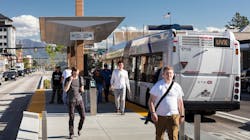Bus Rapid Transit: Early Actions to Position for Implementation
Introduced nearly 20 years ago in the United States, bus rapid transit (BRT) is the fastest growing mode of public transportation in North America, with more than 100 systems operating in cities of all sizes. These systems are successful because they are scalable, improve the passenger experience, promote equity and facilitate economic development. Interest in implementing BRT systems is rapidly growing throughout North America as transit agencies work to provide their passengers with high quality transit that incorporates such components as off-vehicle fare payment, level boarding and unique vehicles and stations. Soon, future vehicles will be electric with cutting-edge automated technology, proving BRT’s staying power is strong.
With the unique components and cost considerations involved, it’s not surprising that the most common question asked by transit agencies is how they can set up and implement a successful BRT project.
Over the course of our careers at AECOM, we have led BRT system development and implementation around the nation, and we have heard this question many times. While we don’t have all the answers, we have worked with agencies to develop strategies that eliminate common project hurdles: managing unexpected costs at the end of the project and delivering funding to cover the entire project scope.
Managing Costs Throughout
A thorough, comprehensive design process that results in accurate cost estimates is the foundation for successful BRT system implementation. Understanding the full impact of the project early in the planning and design phases can set projects up for success by preventing unanticipated costs later in the implementation process that could impact project constructability.
The Utah Transit Authority’s (UTA) Ogden BRT line experienced the struggle of discovering additional impacts later in the implementation process. Several traffic impacts were identified during final design that required more right-of-way than had been anticipated in earlier project phases. The result was an expanded footprint that, in turn, increased the project’s estimated cost. Creative solutions, including working with the Utah Department of Transportation (UDOT) to secure exemptions on certain design standards, helped lower the anticipated overage.
The Rapid’s Laker Line BRT in Grand Rapids, Mich., on the other hand, demonstrated the benefit of understanding the project’s vision during its planning phase. Early in the planning process for the Laker Line, The Rapid worked with its project partners to develop a comprehensive vision for the corridor from which they calculated a bottom-up estimate. This estimate included station designs and other details, such as snow melt within the concrete. As design advanced and new ideas were brought forward, The Rapid only advanced the ideas that supported the project vision. As a result, the cost estimate remained consistent throughout the design process with minimal cost increases which helped to build trust with stakeholders and secure funding from the Federal Transit Administration (FTA).
“Engaging stakeholders early in the planning process and throughout the entire design process allowed us to develop a robust and exhaustive vision of what BRT means for the context of the Laker Line,” said Nicholas Monoyios, project manager for The Rapid’s Laker Line. “Our commitment to a thorough and methodical approach allowed us to solidify the community’s vision while reducing scope creep. When the project went into revenue service in August 2020, the project was $7.1 million under the planning budget and $8.9 million under the construction budget.”
The preliminary engineering phase offers transit agencies real opportunities to understand the project impacts and manage project costs early on. This phase also enables agencies to deploy creative solutions to minimize costs. AECOM’s team of engineers worked with UTA and UDOT to reduce the design speeds on the Utah Valley Express (UVX) BRT, which allowed for shorter tapers coming in and out of the project’s stations and reduced the required right-of-way acquisitions. AECOM also worked with UTA to create a deferred item list for the project that consisted of scope elements that could be added should funding be available after the project and its required items were constructed. Prioritizing these components further managed project costs, ensuring it remained within an implementable budget.
Redirecting Funding Sources
In addition to accurate cost estimates early in the process, it’s important to develop a funding strategy during the planning phase.
“Developing a funding strategy early in the planning process is an important step in developing the vision for the project,” said Gavin Poindexter, AECOM New Starts and Small Starts lead. “Some funding sources require the project to include certain elements (e.g., sidewalks, roadway reconstruction). Developing the vision to qualify for the planned funding sources leads to a solid financial plan.”
One commonly tapped federal funding source is the FTA’s Small Starts program, which is part of the Capital Investment Grants (CIG) program. There are several other sources to consider for BRT system funding. Milwaukee County’s East-West BRT in Wisconsin, for example, used planned bus replacement funds and signal upgrade funds to match the Small Starts grant it received in December 2020. This resulted in a 79 percent federal share of the project’s cost. The city of Madison’s East-West BRT is building upon Milwaukee’s precedent by using FTA formula funds for bus replacement and a Bus and Bus Facilities discretionary grant to increase the federal share from half provided through Small Starts to two-thirds of the project cost being funded through federal sources.
In November 2020, Omaha Metro Transit launched Omaha Rapid Bus Transit (ORBT) but opted not to use FTA’s CIG program. Instead, Omaha Metro secured a 2014 Transportation Investment Generating Economic Recovery (TIGER) grant by harnessing contributions from foundations and private companies, as well as locally controlled federal funding sources such as the Congestion Mitigation Air Quality (CMAQ), Surface Transportation Program (STP), Transportation Alternatives Program (TAP) and Buses and Bus Facilities Program.
As such, there is more than one path to fund and implement a BRT system. Understanding the variety of benefits a BRT system brings to each community is critical when developing an effective funding strategy and creating a project with lasting value.
Looking to the Future
With the many benefits BRT offers to communities, AECOM is hopeful that the Biden Administration will continue to create new funding opportunities for transit capital investments. AECOM anticipates a greater emphasis on electrification and other emerging technologies in these new funding programs.
The company recently helped Houston METRO win a $1.5 million FTA Accelerating Innovative Mobility (AIM) grant to pilot an electric and automated 24-foot shuttle bus. Incorporating innovative features like electric and automated vehicles into BRT projects could qualify projects for new funding sources and ensure the transit projects that are being worked on now will continue to add value for many years into the future.
By providing a high-quality, affordable transportation option to access job opportunities and healthcare services, BRT will continue to play an important role in creating inclusive communities that support the needs of every resident, no matter their background. BRT will reduce greenhouse gases and encourage people to be more active throughout their day. That’s one powerful tool, and by improving a community’s quality of life, it only makes the work more impactful.
------------------------------
Lori Labrum is vice president and U.S. West Region Transit-Rail Division manager at AECOM, a premier infrastructure consulting firm. She has 32 years of engineering and planning experience for transit agencies across the central U.S. Labrum, who has planned and designed more than 50 miles of Bus Rapid Transit (BRT) systems, oversaw Utah Transit Authority’s 10.5-mile BRT project through Provo and Orem, Utah, and was the project manager for the Northern Arizona Transit Authority in Flagstaff.Dayna Wasley, a transportation planner at AECOM, plans resilient and equitable communities by balancing the needs of different road users. Her expertise includes innovative technology implementation, infrastructure financing, active transportation, transportation demand management, community engagement and transit planning. Her innovative work in transportation planning has been recognized by the Women in Transportation Seminar, Arizona Big Media, American Planning Association (Arizona Chapter) and the Association for Commuter Transportation.About the Author

Lori Labrum
Vice President and U.S. West Region Transit-Rail Division Manager, AECOM
Lori Labrum is vice president and U.S. West Region Transit-Rail Division manager at AECOM, a premier infrastructure consulting firm. She has 32 years of engineering and planning experience for transit agencies across the central U.S. Labrum, who has planned and designed more than 50 miles of Bus Rapid Transit (BRT) systems, oversaw Utah Transit Authority’s 10.5-mile BRT project through Provo and Orem, Utah, and was the project manager for the Northern Arizona Transit Authority in Flagstaff.

